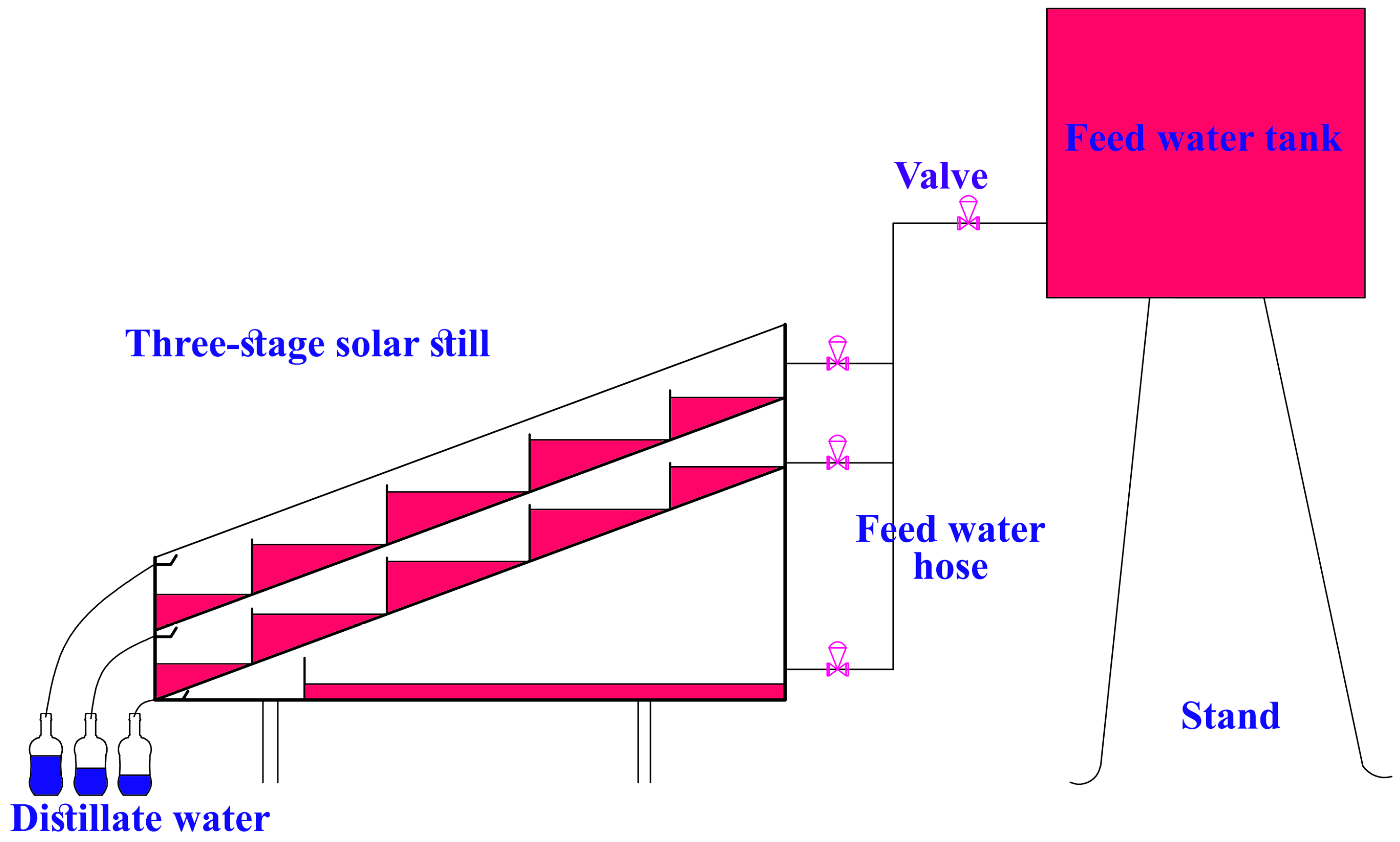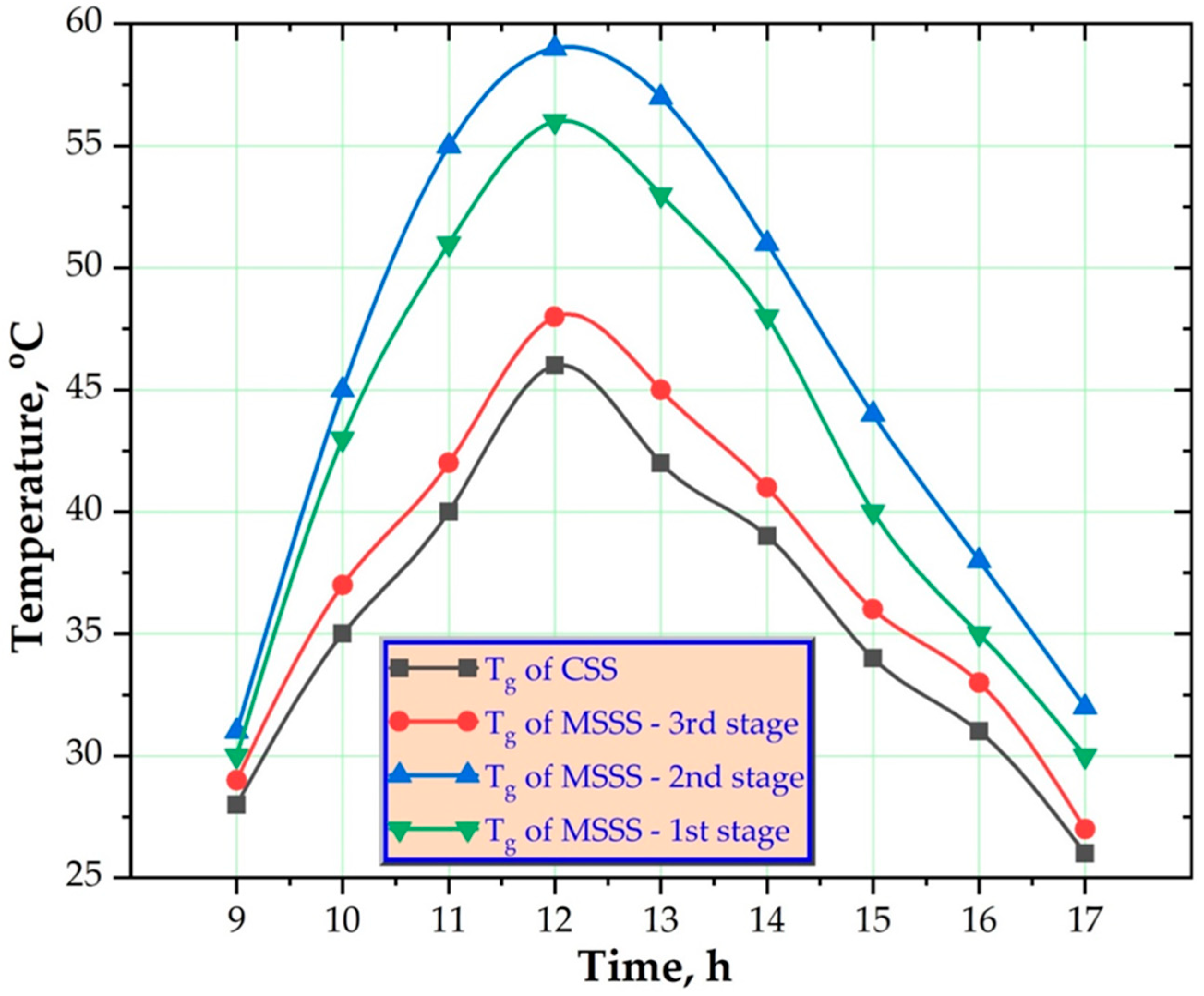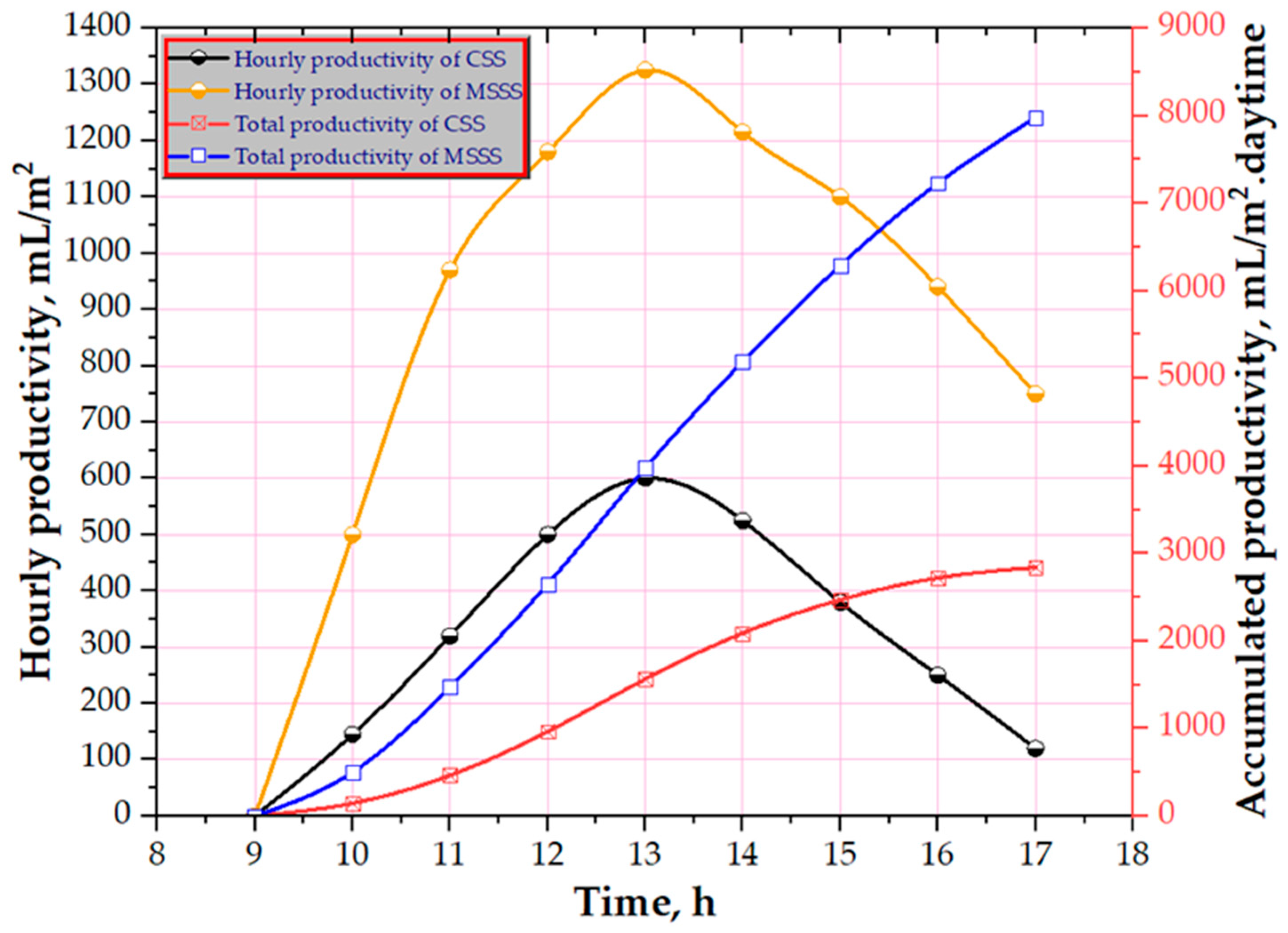Energy, Exergy, Economic, and Environmental Prospects of Solar Distiller with Three-Vertical Stages and Thermo-Storing Material
Abstract
:1. Introduction
2. Methodology
2.1. Manufacturing and Assembly of Solar Stills
2.2. Measuring Instruments
2.3. Uncertainty Analyses
2.4. Steps to Conduct the Experiments
- The thermal performances of the CSS and MSSS were evaluated and compared to obtain the differences between both distillers.
- The operation of the MSSS was tested when employing the thermo-storing material (PCM). The PCM was placed under the base of the absorber in the first stage. The PCM was combined with graphene nanocomposites using paraffin wax. Paraffin wax, a hydrocarbon wax, finds widespread application in various contexts, notably as a phase-change material for thermal energy storage. Paraffin wax typically exhibits a melting point within the range of 46–68 °C. Also, the specific heat capacity of paraffin wax is approximately 2.1–2.5 J/g °C, indicating its ability to absorb and release thermal energy efficiently. Paraffin wax is characterized by a relatively low thermal conductivity, typically falling within the range of 0.2–0.3 W/m °C.
- Finally, the economic, exergy, thermal, and environmental prospects for the CSS and MSSS are evaluated.
3. Results
3.1. Thermal Performance of Solar Distillers (CSS and MSSS)
3.2. Influence of Using PCM on MSSS Performance
3.3. Thermal Efficiency of Investigated Solar Distillers
3.4. Exergy Analyses
3.5. Environmental Analysis
3.6. Economic Analyses
4. Conclusions
- The upper stage was better than that of the other stages of the MSSS.
- Furthermore, the cumulative day production of the CSS was reported to be 1750 compared to 4550 mL/m2 for the MSSS. Therefore, the productivity of the MSSS was increased by about 160%.
- The cumulative daytime outputs of the CSS and MSSS with PCM were 2840 and 7980 mL/m2, respectively, with an improvement of 181%.
- The energy efficiencies of the CSS, MSSS, and MSSS with PCM were 31%, 49.8%, and 53%, respectively. The MSSS with PCM had an exergy efficiency of 5.8%.
- The MSSS with PCM had an environmental impact of 12 tons of carbon dioxide per year.
- The costs of freshwater for the conventional SS, MSSS, and MSSS with PCM were 0.24, 0.13, and 0.10 $/L, respectively.
Author Contributions
Funding
Data Availability Statement
Acknowledgments
Conflicts of Interest
Nomenclature
| Vaporization latent heat at water temperature, J/kg | |
| Productivity, kg/s | |
| Daily efficiency, % | |
| Air temperature, K | |
| Sun temperature, K | |
| Water temperature, K | |
| Price of carbon on the global markets, $/ton | |
| Exergy efficiency, % | |
| and | Environmental variables |
| Area, m2 | |
| CO2 | Carbon dioxide |
| CSS | Conventional solar still |
| Sun irradiation, W/m2 | |
| MSSS | Multi-stage solar still |
| PCM | Phase-change material |
| Annual maintenance costs, $ | |
| Annual salvage value, $ | |
| Price of distillate, $/L | |
| Capital recovery factor | |
| Energy, kW.h | |
| Total fixed expenses, $ | |
| Annual fixed costs, $ | |
| Annual productivity, L/m2·year | |
| Annual working days, day | |
| Salvage value, $ | |
| Sinking fund factor | |
| Annual total cost, $ | |
| Interest rate, % | |
| Lifespan of solar still, year |
References
- Piernavieja, G.; Peñate, B. Review: Desalination Technologies and Renewable Energies. Study Case: PV-RO. 2015. Available online: https://www.irena.org/-/media/Files/IRENA/Agency/Publication/2012/IRENA-ETSAP-Tech-Brief-I12-Water-Desalination.pdf (accessed on 30 October 2023).
- Al-Othman, A.; Tawalbeh, M.; El Haj Assad, M.; Alkayyali, T.; Eisa, A. Novel Multi-Stage Flash (MSF) Desalination Plant Driven by Parabolic Trough Collectors and a Solar Pond: A Simulation Study in UAE. Desalination 2018, 443, 237–244. [Google Scholar] [CrossRef]
- Ali, E.S.; Alsaman, A.S.; Harby, K.; Askalany, A.A.; Diab, M.R.; Ebrahim Yakoot, S.M. Recycling Brine Water of Reverse Osmosis Desalination Employing Adsorption Desalination: A Theoretical Simulation. Desalination 2017, 408, 13–24. [Google Scholar] [CrossRef]
- Gude, V.G.; Nirmalakhandan, N.; Deng, S. Desalination Using Solar Energy: Towards Sustainability. Energy 2011, 36, 78–85. [Google Scholar] [CrossRef]
- Shemer, H.; Semiat, R. Sustainable RO Desalination—Energy Demand and Environmental Impact. Desalination 2017, 424, 10–16. [Google Scholar] [CrossRef]
- Paixão, D.F.S.; Quirino, P.P.S.; Fialho, R.L.; Americano Da Costa, M.V.; Pontes, K.V. A Dynamic Optimization Approach for a Multi-Effect Desalination (MED) Integrated with Thermosolar Storage System. Sol. Energy 2023, 262, 111837. [Google Scholar] [CrossRef]
- Garg, K.; Das, S.K.; Tyagi, H. Thermal Design of a Humidification-Dehumidification Desalination Cycle Consisting of Packed-Bed Humidifier and Finned-Tube Dehumidifier. Int. J. Heat Mass Transf. 2022, 183, 122153. [Google Scholar] [CrossRef]
- Al-Enezi, G.; Ettouney, H.; Fawzy, N. Low Temperature Humidification Dehumidification Desalination Process. Energy Convers. Manag. 2006, 47, 470–484. [Google Scholar] [CrossRef]
- Chong, T.H.; Loo, S.L.; Krantz, W.B. Energy-Efficient Reverse Osmosis Desalination Process. J. Memb. Sci. 2015, 473, 177–188. [Google Scholar] [CrossRef]
- Suzuki, T.; Tanaka, R.; Tahara, M.; Isamu, Y.; Niinae, M.; Lin, L.; Wang, J.; Luh, J.; Coronell, O. Relationship between Performance Deterioration of a Polyamide Reverse Osmosis Membrane Used in a Seawater Desalination Plant and Changes in Its Physicochemical Properties. Water Res. 2016, 100, 326–336. [Google Scholar] [CrossRef]
- Eder, E.; Preißinger, M. Experimental Analysis of the Humidification of Air in Bubble Columns for Thermal Water Treatment Systems. Exp. Therm. Fluid Sci. 2020, 115, 110063. [Google Scholar] [CrossRef] [PubMed]
- Alrbai, M.; Hayajneh, H.S.; Al-Dahidi, S.; Alahmer, A. Thermodynamics Analysis of a Lab Scale Humidification-Dehumidification Desalination System Employing Solar Energy and Fogging Approach. Sol. Energy 2022, 247, 397–407. [Google Scholar] [CrossRef]
- Shaikh, J.S.; Ismail, S. Theoretical Investigation on Humidification–Dehumidification Desalination Employing Flat-Plate Solar Water Collector. J. Therm. Anal. Calorim. 2023, 148, 11835–11853. [Google Scholar] [CrossRef]
- Tiwari, G.N.; Sahota, L. Advanced Solar-Distillation Systems: Basic Principles, Thermal Modeling, and Its Application; Springer: Berlin/Heidelberg, Germany, 2017; ISBN 9789811046711. [Google Scholar]
- Diaf, A.; Cherfa, A.; Karadaniz, L.; Tigrine, Z. A Technical-Economical Study of Solar Desalination. Desalination 2016, 377, 123–127. [Google Scholar] [CrossRef]
- Abu El-Maaty, A.E.; Awad, M.M.; Sultan, G.I.; Hamed, A.M. Solar Powered Fog Desalination System. Desalination 2019, 472, 114130. [Google Scholar] [CrossRef]
- Nwosu, E.C.; Nwaji, G.N.; Ononogbo, C.; Ofong, I.; Ogueke, N.V.; Anyanwu, E.E. Effects of Water Thickness and Glazing Slope on the Performance of a Double-Effect Solar Still. Sci. Afr. 2023, 21, e01777. [Google Scholar] [CrossRef]
- Nayagam, V.S.; Geetha, K.; Vallikannu, R.; Muthuvel, S.K.; Ram, G.C.; Gupta, P.; Sudhakar, M.; Mohanavel, V.; Sathyamurthy, R. Energy Efficient Tubular Solar Still for Augmented Yield Using Electrical Heater. Energy Rep. 2022, 8, 959–964. [Google Scholar] [CrossRef]
- Mohsenzadeh, M.; Aye, L.; Christopher, P. A Review on Various Designs for Performance Improvement of Passive Solar Stills for Remote Areas. Sol. Energy 2021, 228, 594–611. [Google Scholar] [CrossRef]
- Angappan, G.; Pandiaraj, S.; Panchal, H.; Kathiresan, T.; Ather, D.; Dutta, C.; Subramaniam, M.K.; Muthusamy, S.; Kabeel, A.E.; El-Shafay, A.S.; et al. An Extensive Review of Performance Enhancement Techniques for Pyramid Solar Still for Solar Thermal Applications. Desalination 2022, 532, 115692. [Google Scholar] [CrossRef]
- Okampo, E.J.; Nwulu, N. Optimisation of Renewable Energy Powered Reverse Osmosis Desalination Systems: A State-of-the-Art Review. Renew. Sustain. Energy Rev. 2021, 140, 110712. [Google Scholar] [CrossRef]
- Saravanan, A.; Parida, S.; Murugan, M.; Reddy, M.S.; Bora, P.; Sree, S.R. Performance Estimation of Tubular Solar Still with a Wicked Rotating Drum Using DT, LR, and KNN Techniques of Machine Learning. Neural Comput. Appl. 2022, 34, 14415–14425. [Google Scholar] [CrossRef]
- Shanmugan, S.; Djuansjah, J.; Ahmadein, M.; Alsaleh, N.A.; Parsa, S.M.; Elsheikh, A.H. Chemical Potential of Different Phases inside the Pyramid Stepped Basin Solar Still through Gibbs Free Energy. Case Stud. Therm. Eng. 2023, 49, 103277. [Google Scholar] [CrossRef]
- Kabeel, A.E.; Harby, K.; Abdelgaied, M.; Eisa, A. Augmentation of a Developed Tubular Solar Still Productivity Using Hybrid Storage Medium and CPC: An Experimental Approach. J. Energy Storage 2020, 28, 101203. [Google Scholar] [CrossRef]
- Sathyamurthy, R.; Kennady, H.J.; Nagarajan, P.K.; Ahsan, A. Factors Affecting the Performance of Triangular Pyramid Solar Still. Desalination 2014, 344, 383–390. [Google Scholar] [CrossRef]
- Abulkhair, H.; Sharshir, S.W.; Moustafa, E.B.; Alsaiari, A.; Moujdin, I.A.; Elsheikh, A.H. Thermal Performance Enhancement of a Modified Pyramid Distiller Using Different Modifications with Low-Cost Materials. Sustain. Energy Technol. Assess. 2023, 57, 103191. [Google Scholar] [CrossRef]
- Arani, R.P.; Sathyamurthy, R.; Chamkha, A.; Kabeel, A.E.; Deverajan, M.; Kamalakannan, K.; Balasubramanian, M.; Manokar, A.M.; Essa, F.; Saravanan, A. Effect of Fins and Silicon Dioxide Nanoparticle Black Paint on the Absorber Plate for Augmenting Yield from Tubular Solar Still. Environ. Sci. Pollut. Res. 2021, 28, 35102–35112. [Google Scholar] [CrossRef]
- Amiri, A.; Shanbedi, M.; Dashti, H. Thermophysical and Rheological Properties of Water-Based Graphene Quantum Dots Nanofluids. J. Taiwan Inst. Chem. Eng. 2017, 76, 132–140. [Google Scholar] [CrossRef]
- Nazari, S.; Najafzadeh, M.; Daghigh, R. Techno-Economic Estimation of a Non-Cover Box Solar Still with Thermoelectric and Antiseptic Nanofluid Using Machine Learning Models. Appl. Therm. Eng. 2022, 212, 118584. [Google Scholar] [CrossRef]
- Alsehli, M. Application of Graphene Nanoplatelet/Platinum Hybrid Nanofluid in a Novel Design of Solar Still for Improving Water Production and Energy Management. Sustain. Energy Technol. Assess. 2022, 53, 102607. [Google Scholar] [CrossRef]
- Gad, H.E.; El-Gayar, S.M.; Gad, H.E. Performance of a Solar Still with Clothes Moving Wick. 2014. Available online: https://ouci.dntb.gov.ua/en/works/45wO5x39/ (accessed on 30 October 2023).
- Younis, M.; Habchi, C.; Ahmad, M.N.; Ghali, K. Optimization of the Performance of a Solar Still Assisted by a Rotating Drum with a Rough Surface. Sol. Energy 2020, 211, 847–865. [Google Scholar] [CrossRef]
- Hou, J.; Yang, J.; Chang, Z.; Zheng, H.; Su, Y. The Mass Transfer Coefficient Assessment and Productivity Enhancement of a Vertical Tubular Solar Brackish Water Still. Appl. Therm. Eng. 2018, 128, 1446–1455. [Google Scholar] [CrossRef]
- Elashmawy, M. Experimental Study on Water Extraction from Atmospheric Air Using Tubular Solar Still. J. Clean. Prod. 2020, 249, 119322. [Google Scholar] [CrossRef]
- Ahmed, M.E.; Abdo, S.; Abdelrahman, M.A.; Gaheen, O.A. Finned-Encapsulated PCM Pyramid Solar Still—Experimental Study with Economic Analysis. J. Energy Storage 2023, 73, 108908. [Google Scholar] [CrossRef]
- Vigneswaran, V.S.; Kumaresan, G.; Dinakar, B.V.; Kamal, K.K.; Velraj, R. Augmenting the Productivity of Solar Still Using Multiple PCMs as Heat Energy Storage. J. Energy Storage 2019, 26, 101019. [Google Scholar] [CrossRef]
- Hussain, F.; Shaik, S.; Khan, S.A.; Van Huynh, V.; Jilte, R.D.; Sundara, V.; Asif, M.; Linul, E. Transient Solidification and Melting Numerical Simulation of Lauric Acid PCM Filled Stepped Solar Still Basin Used in Water Desalination Process. Case Stud. Therm. Eng. 2023, 49, 103370. [Google Scholar] [CrossRef]
- Afolabi, L.O.; Enweremadu, C.C.; Kareem, M.W.; Arogundade, A.I.; Irshad, K.; Islam, S.; Oladosu, K.O.; Elfaghi, A.M.; Didane, D.H. Experimental Investigation of Double Slope Solar Still Integrated with PCM Nanoadditives Microencapsulated Thermal Energy Storage. Desalination 2023, 553, 116477. [Google Scholar] [CrossRef]
- Yu, C.; Song, Y.S. Enhancing Energy Harvesting Efficiency of Form Stable Phase Change Materials by Decreasing Surface Roughness. J. Energy Storage 2023, 58, 106360. [Google Scholar] [CrossRef]
- Abdelgaied, M.; Zakaria, Y.; Kabeel, A.E.; Essa, F.A. Improving the Tubular Solar Still Performance Using Square and Circular Hollow Fins with Phase Change Materials. J. Energy Storage 2021, 38, 102564. [Google Scholar] [CrossRef]
- Jafar Gholi Beik, A.; Assari, M.R.; Basirat Tabrizi, H. Passive and Active Performance of a Multi-Side-Stepped Square Pyramid Solar Still; Experimental and Modeling. J. Energy Storage 2020, 32, 101832. [Google Scholar] [CrossRef]
- Essa, F.A.; Abdullah, A.S.; Omara, Z.M. Improving the Performance of Tubular Solar Still Using Rotating Drum—Experimental and Theoretical Investigation. Process Saf. Environ. Prot. 2021, 148, 579–589. [Google Scholar] [CrossRef]
- Saleh, B.; Essa, F.A.; Aly, A.; Alsehli, M.; Panchal, H.; Afzal, A.; Shanmugan, S. Investigating the Performance of Dish Solar Distiller with Phase Change Material Mixed with Al2O3 Nanoparticles under Different Water Depths. Environ. Sci. Pollut. Res. 2022, 29, 28115–28126. [Google Scholar] [CrossRef]
- Holman, J.P. Experimental Methods for Engineers, 8th ed.; Lange, M., Ed.; McGraw-Hill Companies: New York, NY, USA, 2011; ISBN 9780073529301. [Google Scholar]
- Mohammed, S.A.; Basem, A.; Omara, Z.M.; Alawee, W.H.; Dhahad, H.A.; Essa, F.A.; Abdullah, A.S.; Majdi, H.S.; Alshalal, I.; Isahak, W.N.R.W.; et al. Pyramidal Solar Stills via Hollow Cylindrical Perforated Fins, Inclined Rectangular Perforated Fins, and Nanocomposites: An Experimental Investigation. Sustainability 2022, 14, 14116. [Google Scholar] [CrossRef]
- Alsehli, M.; Essa, F.A.; Omara, Z.M.; Othman, M.M.; Elsheikh, A.H.; Alwetaishi, M.; Alghamdi, S.; Saleh, B. Improving the Performance of a Hybrid Solar Desalination System under Various Operating Conditions. Process Saf. Environ. Prot. 2022, 162, 706–720. [Google Scholar] [CrossRef]
- Prasanna, Y.S.; Deshmukh, S.S. Energy, Exergy and Economic Analysis of an Air Cavity Appended Passive Solar Still of Different Basin Material at Varying Depth. Energy Sustain. Dev. 2022, 71, 13–26. [Google Scholar] [CrossRef]
- Mohammed, R.H.; Radwan, A.; Rezk, A.; Olabi, A.G.; Sharma, V.; Kalam Hossain, A.; Alaswad, A.; Abdelkareem, M.A. Energy and Exergy Study of the Integrated Adsorption-Absorption System Driven by Transient Heat Sources for Cooling and Desalination. Energy Convers. Manag. 2023, 277, 116614. [Google Scholar] [CrossRef]
- Dwivedi, V.K.; Tiwari, G.N. Thermal Modeling and Carbon Credit Earned of a Double Slope Passive Solar Still. Desalin. Water Treat. 2010, 13, 400–410. [Google Scholar] [CrossRef]
- Yousef, M.S.; Hassan, H. Assessment of Different Passive Solar Stills via Exergoeconomic, Exergoenvironmental, and Exergoenviroeconomic Approaches: A Comparative Study. Sol. Energy 2019, 182, 316–331. [Google Scholar] [CrossRef]
- Sahota, L.; Shyam; Tiwari, G.N. Energy Matrices, Enviroeconomic and Exergoeconomic Analysis of Passive Double Slope Solar Still with Water Based Nanofluids. Desalination 2017, 409, 66–79. [Google Scholar] [CrossRef]
- Bait, O. Exergy, Environ–Economic and Economic Analyses of a Tubular Solar Water Heater Assisted Solar Still. J. Clean. Prod. 2019, 212, 630–646. [Google Scholar] [CrossRef]







| Measuring Tool | Parameter | Resolution | Error | Range |
|---|---|---|---|---|
| Pyranometer | Solar radiation | 0.1 W/m2 | ±1 W/m2 | 0–5000 W/m2 |
| Temperature sensor | Temperature | 0.1 °C | ±0.5 °C | −55–150 °C |
| Capacitive humidity sensor | Air relative humidity | 1% RH | ±2% RH | 0% to 100% RH |
| Anemometer | Air velocity | 0.01 m/s | ±0.1 m/s | 0–30 m/s |
| Water flask | Productivity | 0.1 mL | 0.2 mL | 0–2500 mL |
| No | Case | Daytime Distillate | Productivity Increase | Efficiency |
|---|---|---|---|---|
| 1 | CSS | 2180 mL/m2 | Reference still | 31% |
| 2 | MSSS | 1750 mL/m2 for CSS | 160% | 49.8% |
| 4550 mL/m2 for MSSS | ||||
| 3 | MSSS + PCM | 2840 mL/m2 for CSS | 181% | 53% |
| 7980 mL/m2 for MSSS + PCM |
| Component | Made from | Energy Density, kW·h/kg | Embodied Energy, Ein (kW·h) |
|---|---|---|---|
| Coating | Black paint | 25 | 3.2 |
| Basin | Glass | 13.8 | 140 |
| Tapes | Brass | 17.22 | 4.1 |
| Cover | Glass | 4.16 | 40 |
| Total | 187.3 | ||
| MSSS with PCM | Embodied Energy = Ein | Eout Yearly | Eout for Lifetime | ||
|---|---|---|---|---|---|
| 187.3 (kW·h) | 220 (kW·h) | 4400 (kW·h) | 174 | 12 |
| No. | Parameter | Description | Amount |
|---|---|---|---|
| 1. | Lifetime of device | 20 years | |
| 2. | Interest rate | 18% | |
| 3. | Annual working days | 340 days | |
| 4. | Total fixed expenses | 120$ for CSS | |
| 170$ for MSSS | |||
| 180$ for MSSS with PCM | |||
| 5. | Annual productivity | 18,000 L/m2·year for CSS | |
| 46,850 L/m2·year for MSSS | |||
| 51,600 L/m2·year for MSSS with PCM |
| No. | Relation | Description |
|---|---|---|
| 1. | Capital recovery factor | |
| 2. | Annual fixed costs | |
| 3. | Sinking fund factor | |
| 4. | Salvage value | |
| 5. | Annual salvage value | |
| 6. | Annual maintenance costs | |
| 7. | Annual total cost | |
| 8. | Price of distillate |
Disclaimer/Publisher’s Note: The statements, opinions and data contained in all publications are solely those of the individual author(s) and contributor(s) and not of MDPI and/or the editor(s). MDPI and/or the editor(s) disclaim responsibility for any injury to people or property resulting from any ideas, methods, instructions or products referred to in the content. |
© 2023 by the authors. Licensee MDPI, Basel, Switzerland. This article is an open access article distributed under the terms and conditions of the Creative Commons Attribution (CC BY) license (https://creativecommons.org/licenses/by/4.0/).
Share and Cite
Bacha, H.B.; Abdullah, A.S.; Essa, F.A.; Omara, Z.M. Energy, Exergy, Economic, and Environmental Prospects of Solar Distiller with Three-Vertical Stages and Thermo-Storing Material. Processes 2023, 11, 3337. https://doi.org/10.3390/pr11123337
Bacha HB, Abdullah AS, Essa FA, Omara ZM. Energy, Exergy, Economic, and Environmental Prospects of Solar Distiller with Three-Vertical Stages and Thermo-Storing Material. Processes. 2023; 11(12):3337. https://doi.org/10.3390/pr11123337
Chicago/Turabian StyleBacha, Habib Ben, AbdelKader S. Abdullah, Fadl A. Essa, and Zakaria M. Omara. 2023. "Energy, Exergy, Economic, and Environmental Prospects of Solar Distiller with Three-Vertical Stages and Thermo-Storing Material" Processes 11, no. 12: 3337. https://doi.org/10.3390/pr11123337







